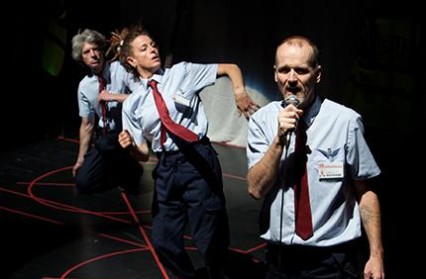Jane Oriel casts a critical eye over Mr and Mrs Clark’s Smash It Up at Chapter Arts Centre in Cardiff.
The expectation was that this would show be edgy, controversial and bloody angry; and I too was bloody angry about the core subject matter – the destruction of the Chartist mural in Newport and the related debate about ownership of public and private art – so it was reasonable to think the audience and performers would accord.
Once invited into the theatre space, we entered a kind of museum where the exhibits were a collection of artistic expressions, numerically laid out on a series of tables, all having been made from intellectual detritus of some sorts; books, religious iconography or even LPs, showing the eternal loop of making, destroying and making again, which has been true of nation and individual throughout time. Once the show started, the three performers went through a lot of militaristic health and fitness moves, shouting, very angry faces and a painfully loud and fast moving, cut ‘n’ paste montage video. All’s fine so far. It is tense and brain-invading; the audience obediently jump aboard the agitprop, agro-nihilism.
But then, just when one might expect the philosophies and direction to start to coalesce, a member of the audience is invited to join two of the performers, to be dressed like them in a carpenter’s apron, protective gloves and goggles and given a hammer with which to destroy in turn three objects that had previously been explained to be carrying highly significant emotional weight for each of the three performers. This is where Mr and Mrs Clark miss a wide open goal. When the audience member did exactly as bidden (as the chosen one probably does on every night of the run), be it setting about sawing a teddy bear in half, wrecking a treasured 30 year old cassette tape, or smashing up a childhood drawing, no wider questions are asked. What about those directly or indirectly involved in destroying the Chartist mural? Were they just doing as they were told as well? What if tonight’s young guest had refused to do this, respecting instead the intrinsic value of these personal objects that she had no right to break other than her being told to do so? She, of course was an innocent, a patsy to the purpose, but no points were raised when everyone knows the Stanford prison experiment and its disturbing ramifications about permission.
A scene involving the three of them sat around a long table, reproducing to some degree a concurrently running video of themselves doing the same in situ outside the Westgate Hotel in Newport, (the place of the original Chartist showdown) carried hints of effectiveness but the tug-of-war with the table was never even vaguely explained. Was this a reference to Kurt Joos’ famous Green Table dance portraying boardroom warmongering? Marega Palser, Mrs Clark, was involved with dance theorists to some degree in her earlier career, as is explained in a later section when each player talks with disappointment about not having had their nascent artistic impulses properly recognised.
We then see video footage of them, amongst other things, bothering the Newport police by silently attaching themselves with cordon tape to gates and the public art just along from The Wave. The video coverage is imbued with more earnest gravitas than it probably deserves and there is a strong suspicion the whole show has one eye firmly on the publicising this and related stunts.
There’s also a breakneck series of important quotes about what art is that are spat out by all three, nearing frenzy, including one nearer to home from Welsh poet and playwright Patrick Jones who was quoted as saying “Mr and Mrs Clark are attention seeking fakers.”
From here, a long list of the names of important modern artists and thinkers are read out (including our much missed Kim Fielding), while simultaneously seeing each name projected visually in turn. Quick frames of work by each artist would have made better use of the multi-media format.
Disappointingly, the performance hardly grasped its subject matter and towards the end, when it fell in to quiet, gathering up of so many books and papers that had been torn and strewn, part of the dialogue included a quote helpfully admonishing us not to take ourselves too seriously.
The destruction of our art, our libraries and the increasing private ownership of so much that used to be in public hands – our hands – is a topic really worth getting angry about, but this show fell short of its manifest. Hot white heat and noise has its pure place in protest, but as a performance this lacked viable intellectual discussion leaving it little more than self-indulgent.
To find out more about upcoming events at the Chapter Arts Centre visit their website.
Jane Oriel is a regular contributor to Wales Arts Review.












